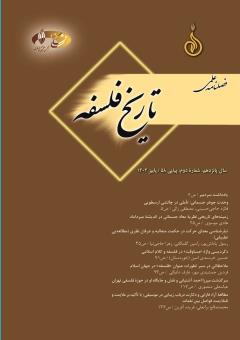سرگذشت میرزا احمد آشتیانی و نقش و جایگاه او در حوزۀ فلسفی تهران
محورهای موضوعی : یافتههای نو درباره چهرهها و مدرسههای فلسفی ایران و جهان اسلام
1 - دانشیار گروه الهیات، دانشگاه رازی، کرمانشاه، ایران
کلید واژه: میرزا احمد آشتیانی, حوزة فلسفی تهران, حکمای معاصر, فلسفه در ایران, مکتب تفکیک, حکمای تهران,
چکیده مقاله :
میرزا احمد آشتیانی از بزرگان حوزة فلسفی تهران و از ارکان اصلی انتقال فلسفه به طبقات متأخرتر بشمار میرود. میزان اهتمام و اشتغال او به فلسفه و عرفان، بگونهیی است که میتوان وی را در طبقۀ اهل فلسفه جای داد. او در مکتب ميرزا ابوالحسن جلوه، تحصيل نمود و از محضر آقاعلى مدرس زنوزى بهره برد تا آنکه خود در علوم عقلى صاحبنظر گرديد، بگونهیی که در جلسة درس اسفار او فضلاى درجة اول نجف که بسيارى از آنها مجتهد مسلم بودند، شرکت میکردند. میرزا احمد به تأیید بزرگانی چون سید جلالالدین آشتیانی، بر مباحث عرفانى تسلط کامل داشت و در طرح مباحث عرفان نظری از دقت نظر بالایی برخوردار بود. نوشتار حاضر مشتمل بر دو بخش است. در بخش اول، سرگذشت میرزا احمد، ولادت و خاندان، مقام علمی، اساتید، شاگردان، آثار و خصوصیات اخلاقی وی، بررسی شده و بخش دوم، به اشتراکها و افتراقهای وی با عموم حکمای حوزة فلسفی تهران میپردازد.
Mīrzā Aḥmad Āshtīyānī was one of the great figures of Tehran School of Philosophy and one of the main pillars of the transfer of philosophy to later generations. His involvement in philosophy and gnosis was to the extent that he can be considered a philosopher. He studied in the school of Mīrzā Abulḥassan Jelwah and benefitted from the classes of Āqā ‘Alī Modarres Zunuzi until he became an authority in rational sciences. This is supported by the fact that some of the high-level scholars of Najaf, many of whom were well-known jurisprudents, participated in his al-Asfār classes. As acknowledged by some prominent figures such as Sayyid Jalāl al-Dīn Āshtīyānī, Mīrzā Aḥmad Āshtīyānī was a master of gnostic debates and manifested great accuracy in discussing various problems in theoretical gnosis. The present paper consists of two parts. The first deals with the biography of Mīrzā Aḥmad, his birth and family, scientific status, masters, students, works, and moral characteristics, and the second part details the similarities and differences between his views and those of most of the philosophers of the Tehran School of Philosophy.
